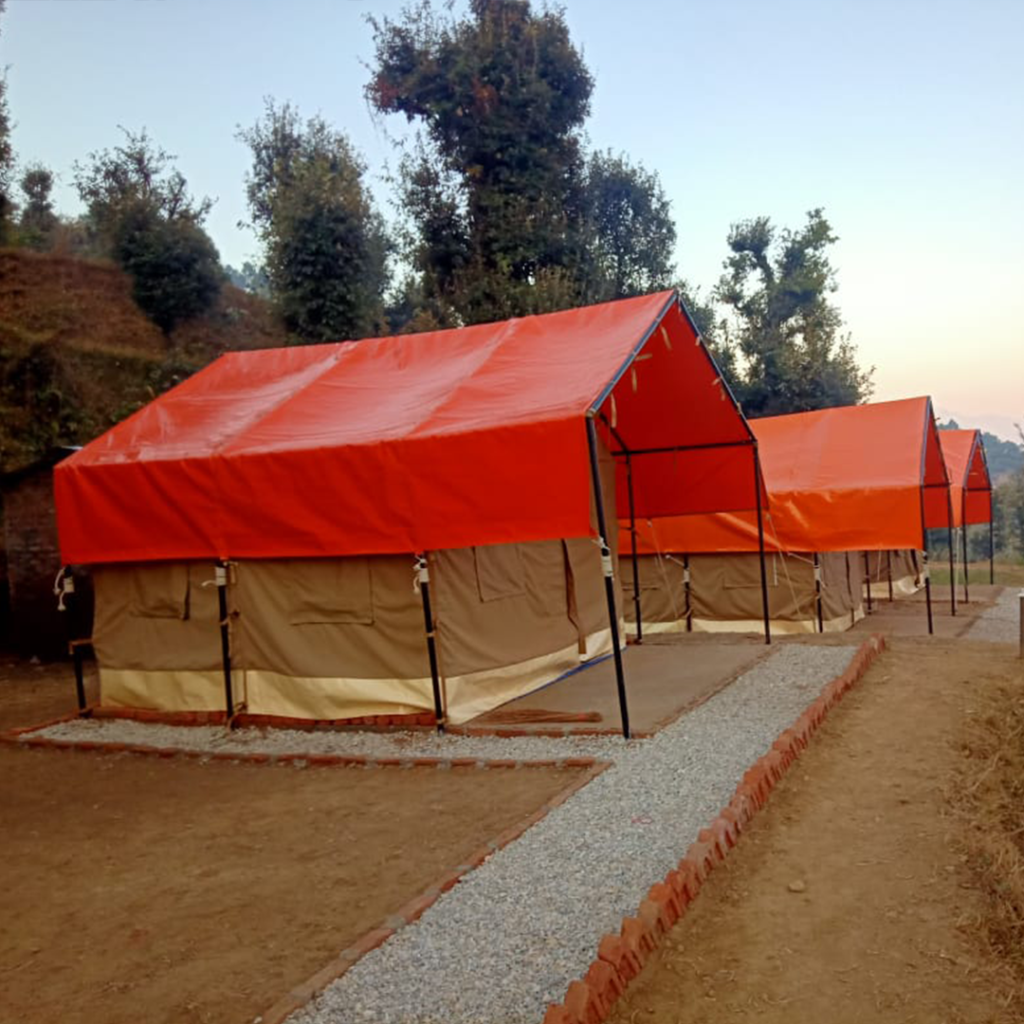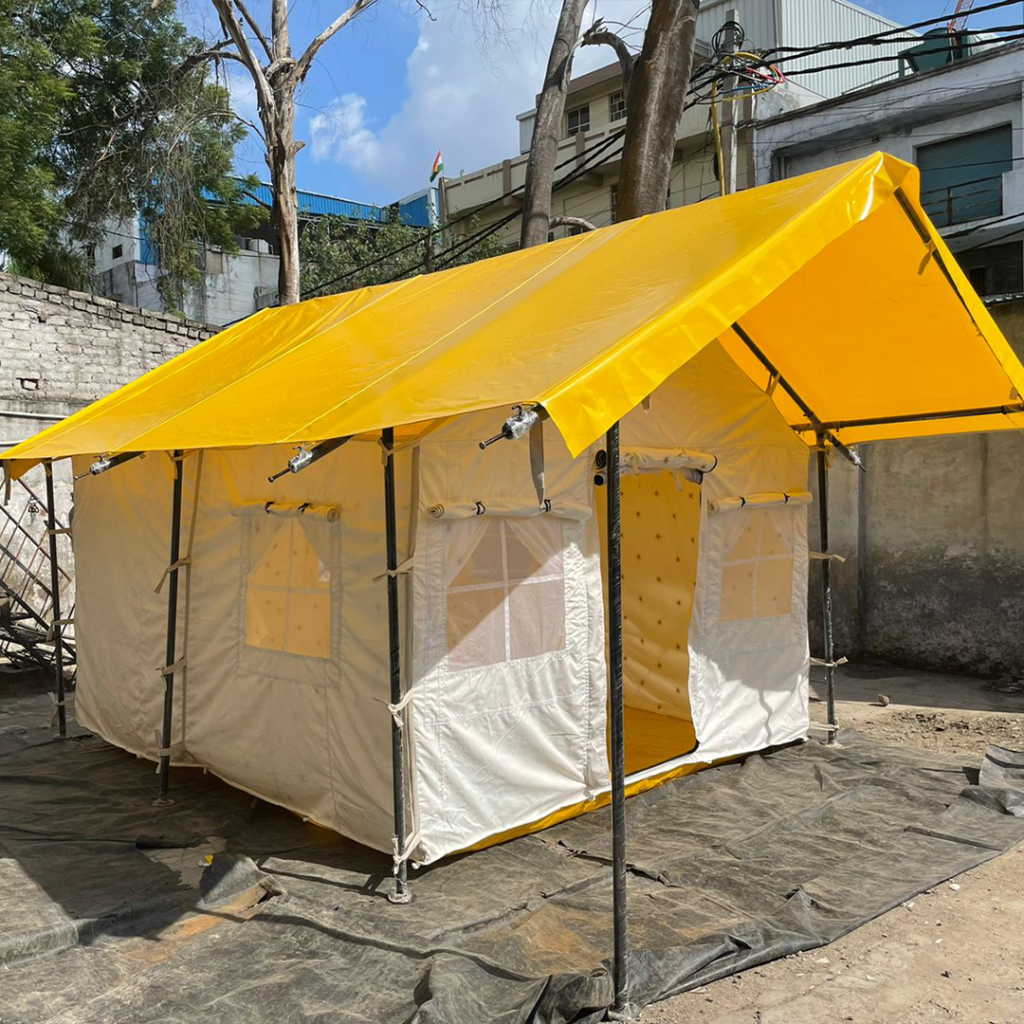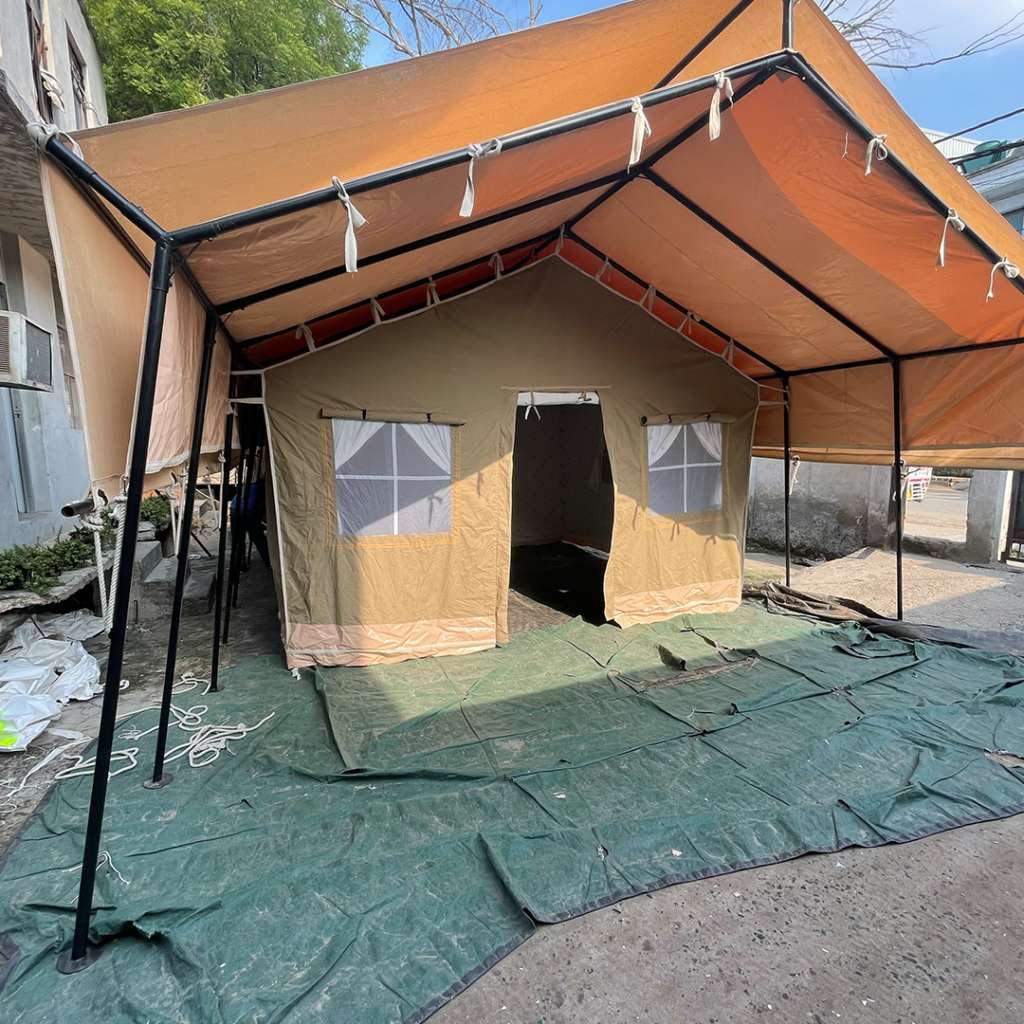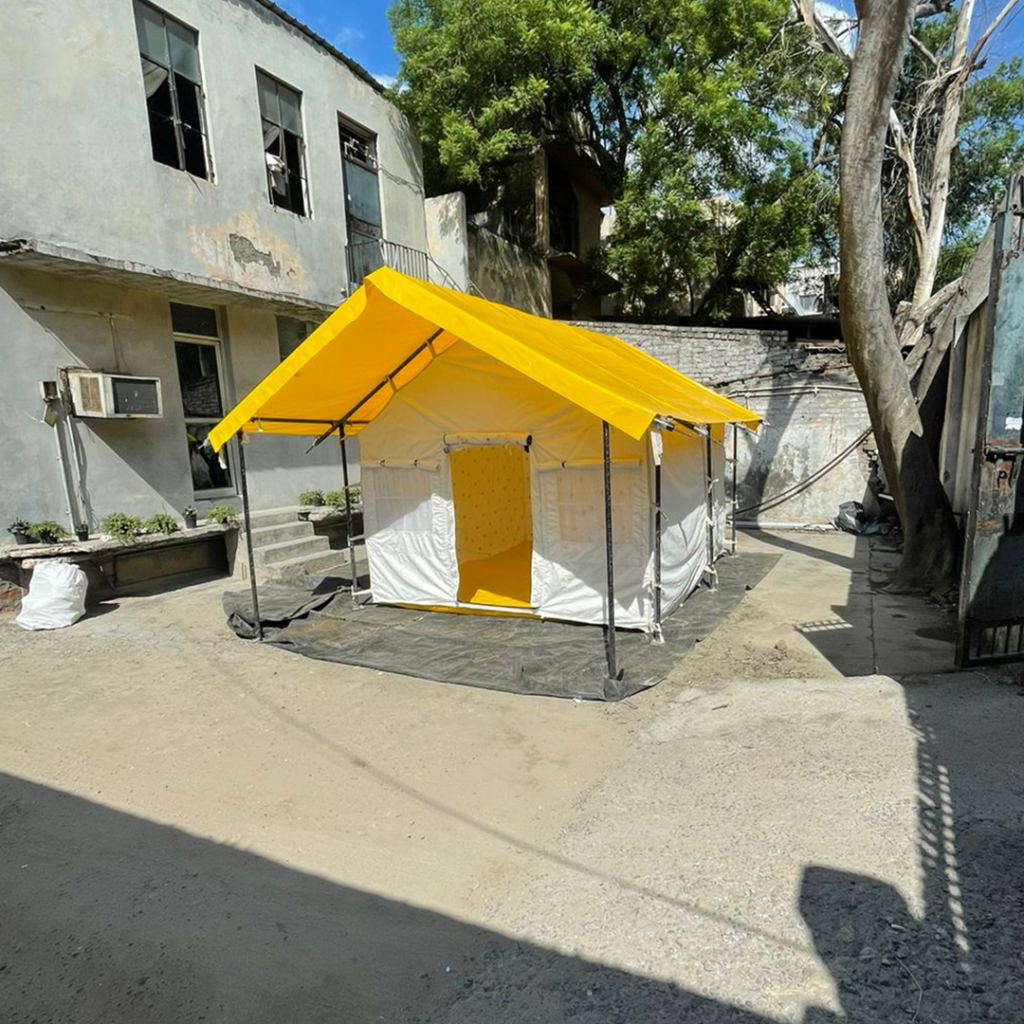Table of Contents
Safari tents, once a niche choice for the adventurous, have become a symbol of luxurious camping experiences. As more people seek unique ways to connect with nature, these tents have risen in popularity, offering a blend of comfort, sustainability, and a touch of adventure. Let’s embark on a journey to explore the world of safari tents, from their historical roots to their modern-day applications. You Can Also Visit Aadi Tents For Other Glamping Options
I. Introduction
A. Definition of Safari Tents
Welcome to the world of Safari Tents, where the allure of camping meets the luxury of a hotel stay. Safari tents, also known as glamping tents, redefine the traditional camping experience by offering a unique blend of comfort, style, and a touch of adventure. Unlike conventional tents, these accommodations boast spacious interiors, raised platforms, and amenities that rival those found in cozy hotel rooms.
B. Growing Popularity
In recent years, there has been a notable surge in the popularity of safari tents. This trend is not confined to seasoned campers; it extends to individuals eager to explore the great outdoors without compromising on comfort. The growing appeal of safari tents lies in their ability to provide an unforgettable experience that combines the thrill of camping with the luxury of a hotel stay.
C. Unique Features
What sets safari tents apart are their unique features. Crafted with sturdy materials, often using durable canvas, these tents are designed to withstand various weather conditions. Innovative design elements, such as zippered windows and mesh panels, allow campers to fully immerse themselves in nature while maintaining a comfortable and secure environment.

II. History of Safari Tents
A. Origin and Evolution
The history of safari tents traces back to the bygone era of colonial Africa, where they served as essential accommodations for explorers embarking on safari expeditions. These early tents were more functional than luxurious, designed to provide shelter during extended journeys into the wilderness. The canvas construction, known for its durability and resilience, was a hallmark feature even in these nascent stages.
As time progressed, the concept of safari tents evolved in response to changing preferences and technological advancements. What began as a practical solution for shelter transformed into an emblem of style and comfort. The evolution mirrored the shifting attitudes towards camping, emphasizing not only the need for protection against the elements but also the desire for a more refined outdoor experience.
B. Cultural Significance
Beyond their practical origins, safari tents acquired cultural significance, embodying the spirit of adventure and exploration. They became more than just temporary abodes; they symbolized a connection with nature and the untamed wild. The cultural allure of safari tents expanded beyond the African safari, influencing camping experiences worldwide.
In different cultural contexts, these tents became associated with the thrill of the unknown and the romance of outdoor living. The image of a safari tent pitched under the vast expanse of the African sky resonated not only with seasoned adventurers but also with those seeking a unique and immersive way to commune with nature.
III. Safari Tent Design and Structure
A. Materials Used
Safari tents boast a robust construction, primarily utilizing durable and weather-resistant materials. Canvas stands out as a popular choice due to its strength and ability to withstand various environmental conditions. The canvas is not only durable but also provides excellent breathability, ensuring a comfortable interior climate for campers. The use of high-quality materials contributes to the overall sturdiness of safari tents, making them reliable shelters for outdoor enthusiasts.
B. Key Design Elements
The design of safari tents incorporates several key elements that enhance both functionality and comfort. One notable feature is the presence of zippered windows, allowing campers to control ventilation and adjust the tent’s temperature according to their preferences. Mesh panels are strategically placed to promote airflow while keeping insects at bay. The raised platform is another integral design aspect, elevating the tent off the ground to provide a level surface and protection from moisture. This design element not only contributes to the tent’s structural integrity but also ensures a more comfortable camping experience.
C. Sustainability
In response to the growing demand for eco-friendly alternatives, many safari tents prioritize sustainability in their design and construction. Manufacturers often implement eco-conscious practices, such as using recycled materials in the production process. Additionally, sustainable wood may be incorporated into the structure, aligning the tents with broader environmental conservation efforts. The commitment to sustainability extends beyond the camping experience, resonating with environmentally conscious consumers who seek products that minimize their ecological footprint. By embracing sustainable practices, safari tents contribute to the larger movement towards greener and more responsible outdoor recreation options.

IV. Safari Tent Camping Experience
Safari tent camping offers an unparalleled adventure, seamlessly blending the thrill of traditional camping with the comfort and style of a luxurious retreat. Let’s delve into the heart of the safari tent camping experience, exploring the most captivating destinations, the myriad benefits, and invaluable tips for those embarking on this unique outdoor adventure.
A. Popular Destinations
Safari tent camping is no longer confined to the vast landscapes of Africa; it has transcended borders to become a global phenomenon. From the enchanting savannas of Kenya to the rugged terrains of the American wilderness and the serene beauty of European countrysides, there’s a safari tent destination for every adventurer. Discovering these diverse locations adds a rich tapestry to the overall camping experience, providing a unique opportunity to connect with nature in different corners of the world.
B. Benefits of Safari Tent Camping
The allure of safari tent camping lies in its ability to offer the best of both worlds — the raw, unfiltered beauty of the outdoors coupled with the creature comforts that one might find in a hotel. Picture yourself nestled in a well-appointed tent with plush bedding, enjoying the sounds of nature without sacrificing the convenience of electricity and private bathroom facilities. It’s a camping experience where comfort meets adventure, allowing campers to unwind in style after a day of exploration.
C. Tips for First-Time Safari Tent Campers
For those venturing into safari tent camping for the first time, a few handy tips can transform the experience from good to extraordinary. Efficient packing, embracing the outdoor setting, and acquiring basic camping skills are essential elements for a successful safari tent adventure. The transition from traditional camping to the safari tent experience is made smoother with insights on how to make the most of the unique features these tents offer. Whether it’s stargazing through the tent’s open design or immersing oneself in the natural surroundings, these tips pave the way for an unforgettable camping escapade.
V. Safari Tents vs. Traditional Camping
A. Comfort and Amenities
Safari tents redefine the camping experience by offering a level of comfort and amenities that go beyond the traditional camping setup. Unlike traditional tents that often come with basic sleeping bags and mats, safari tents are equipped with comfortable bedding, sometimes even resembling a cozy hotel room. The inclusion of electricity, lighting, and private bathroom facilities adds a touch of luxury to the camping adventure, making it more accessible and appealing to a broader audience.
B. Connection with Nature
While safari tents prioritize comfort, they successfully maintain a strong connection with nature. The design of these tents, with large windows and an open layout, allows campers to immerse themselves in the natural surroundings. The sounds of the wilderness, the feel of the breeze, and the sight of the stars create a sensory experience that enhances the overall enjoyment of camping. Safari tents strike a delicate balance, providing a comfortable shelter while ensuring campers can still appreciate and connect with the beauty of the outdoors.
C. Accessibility
Safari tents are designed with accessibility in mind, making camping a viable option for individuals who may be hesitant to embrace traditional camping. The inclusion of comfortable bedding, electricity, and private amenities attracts a diverse range of campers, including those who may not be comfortable with the idea of roughing it in the wilderness. This accessibility opens up the world of camping to a broader audience, encouraging more people to experience the joys of outdoor living without compromising on comfort and convenience.

VI. Safari Tents for Events
A. Weddings and Celebrations
Safari tents have transcended their traditional camping roots and found a new home in the realm of celebrations. Couples seeking a unique and memorable wedding experience are opting for safari tent setups in picturesque locations. Imagine saying your vows surrounded by the beauty of nature, under the canopy of a carefully decorated safari tent. These tents provide an enchanting atmosphere, combining the romance of a wedding with the adventure of the outdoors.
The versatility of safari tents extends to various celebrations, from milestone birthdays to anniversaries. The open and spacious design allows for creative decorations, creating a festive ambiance that traditional indoor venues may struggle to replicate. The trend of hosting celebrations in safari tents is not merely about the event itself; it’s about crafting an immersive and unforgettable experience for everyone involved.
B. Corporate Retreats
In the realm of corporate events, safari tents are emerging as a novel and effective alternative to conventional meeting spaces. Companies are realizing the benefits of hosting corporate retreats in the great outdoors, surrounded by the tranquility that nature provides. The blend of business and pleasure fosters a unique environment for team building, brainstorming sessions, and strategic planning.
Safari tents offer a departure from the monotony of boardrooms, providing a refreshing change of scenery that stimulates creativity and innovation. Employees find themselves engaged in discussions amidst the natural backdrop, fostering a sense of relaxation that traditional corporate settings often lack. The shift towards corporate retreats in safari tents reflects a growing recognition of the positive impact that environment and atmosphere can have on productivity and team dynamics.
VII. Safari Tent Maintenance
Proper maintenance of safari tents is crucial to ensure longevity and a continued enjoyable camping experience. As with any outdoor equipment, these tents require regular care and attention to preserve their structural integrity and comfort. Let’s delve into the details of safari tent maintenance to keep your temporary abode in top-notch condition.
A. Cleaning and Storage
Maintaining a clean safari tent is essential for its durability and overall appeal. After each camping trip, follow these steps:
1. Spot Cleaning:
- Immediately address any stains or spills on the tent fabric.
- Use a mild soap solution and a soft brush or sponge to gently clean the affected area.
2. Full Cleaning:
- Set up the tent and clean the entire surface with a gentle, non-detergent soap.
- Avoid harsh chemicals as they can damage the tent material.
- Thoroughly rinse and air-dry the tent before storage.
3. Mold and Mildew Prevention:
- Ensure the tent is completely dry before packing to prevent mold growth.
- Store the tent in a cool, dry place to minimize the risk of mildew.
B. Longevity Tips
To extend the lifespan of your safari tent, consider the following longevity tips:
1. Invest in Quality:
- Purchase a high-quality safari tent from reputable manufacturers.
- Quality materials and construction contribute significantly to durability.
2. Follow Manufacturer Guidelines:
- Adhere to the manufacturer’s guidelines for setup, takedown, and maintenance.
- Each tent may have specific recommendations for care.
3. Inspect Regularly:
- Before each use, inspect the tent for any signs of wear, tear, or damage.
- Promptly address any issues to prevent them from worsening.
4. Proper Storage:
- When not in use, store the tent in a breathable storage bag.
- Avoid compressing the tent, as this can damage the fabric and seams.
5. Ventilation:
- Allow the tent to air out after use to prevent trapped moisture.
- Proper ventilation reduces the risk of mold and mildew formation.
6. Avoid UV Exposure:
- Prolonged exposure to sunlight can weaken tent materials.
- If possible, set up the tent in shaded areas to minimize UV exposure.
By incorporating these cleaning and maintenance practices into your routine, you’ll not only ensure the longevity of your safari tent but also enhance your overall camping experience. Remember, a well-maintained tent is a gateway to countless adventures in nature.

VIII. DIY Safari Tents
A. Building Your Own
For the adventurous and crafty individuals, building a DIY safari tent can be a rewarding and personalized experience. While purchasing a ready-made tent is convenient, constructing your own allows for customization and a sense of accomplishment.
Creating a DIY safari tent involves a few key steps:
- Research and Design: Start by researching different tent designs and styles. Consider the size, materials, and features you want. This phase allows you to tailor the tent to your specific needs.
- Gathering Materials: Once you have a design in mind, gather the necessary materials. Canvas, PVC pipes, and sturdy ropes are common components. Opt for high-quality materials to ensure durability.
- Cutting and Sewing: Carefully cut the canvas to the desired size and sew the pieces together. This step requires precision, so take your time to ensure a proper fit. Reinforce seams for added strength.
- Frame Construction: Use PVC pipes or other suitable materials to create a frame for your tent. This frame will provide structure and support. Ensure that the frame is stable and can withstand outdoor conditions.
- Assembling the Tent: Put your sewing and construction skills to the test by assembling the tent. Attach the canvas to the frame securely, ensuring a snug fit. Pay attention to details such as zippers and windows.
- Waterproofing: To enhance the tent’s durability, apply a waterproofing agent to the canvas. This step is crucial for keeping you dry during unexpected rain showers.
- Adding Personal Touches: Customize your DIY safari tent with personal touches. Consider adding interior decorations, comfortable bedding, and any amenities that will enhance your camping experience.
- Testing and Adjusting: Before venturing into the great outdoors, set up your DIY tent in your backyard or a controlled environment. Test its stability and make any necessary adjustments. This step ensures that your creation is ready for real camping scenarios.
Building your own safari tent not only provides a unique camping experience but also allows you to develop practical skills and unleash your creativity. Whether you’re a seasoned DIY enthusiast or a novice looking for a weekend project, constructing a safari tent from scratch can be a fulfilling endeavor. Embrace the challenge and enjoy the satisfaction of camping in a shelter crafted with your own hands.
IX. Safari Tents in Popular Culture
A. Influences in Media
Safari tents have made a significant impact on popular culture, finding their way into various forms of media. From movies featuring extravagant glamping scenes to TV shows showcasing the allure of safari tent camping, these structures have become iconic symbols of adventure and luxury.
B. Celebrity Endorsements
Celebrities, known for their love of unique experiences, have endorsed safari tents as the ultimate way to connect with nature without compromising on comfort. Their social media posts featuring glamorous camping setups have fueled the trend, making safari tents a must-try for fans seeking a taste of the celebrity lifestyle.
X. Challenges and Solutions
A. Weather and Environmental Concerns
Safari tent camping, despite its allure, comes with its set of challenges, particularly related to weather and the environment. The unpredictable nature of the outdoors can pose obstacles to an otherwise idyllic camping experience.
1. Weather Worries
The first challenge revolves around weather conditions. While safari tents are designed to withstand various elements, unexpected rain, storms, or extreme temperatures can catch even seasoned campers off guard. Ensuring preparedness for diverse weather scenarios becomes crucial.
Solution: Versatile Gear
Investing in versatile camping gear, including waterproof equipment, insulated layers, and sturdy tents designed for different climates, helps mitigate the impact of adverse weather conditions.
2. Environmental Impact
Camping in natural habitats demands a heightened awareness of one’s environmental impact. Irresponsible camping practices can harm ecosystems and disrupt wildlife, contradicting the very essence of the safari experience.
Solution: Leave No Trace
Embracing the “Leave No Trace” principles becomes paramount. This involves packing out all waste, minimizing campfire impact, and respecting wildlife habitats. Responsible camping ensures the preservation of the natural beauty that draws people to safari tent experiences.
3. Safety Measures
Beyond weather and environmental concerns, ensuring the safety of campers is a priority. Remote locations and proximity to wildlife add an extra layer of consideration for those venturing into safari tent camping.
Solution: Knowledge and Preparedness
Acquiring knowledge about the local flora and fauna, understanding emergency procedures, and carrying necessary safety equipment enhance the overall camping experience. Preparedness, both in terms of equipment and knowledge, is the key to a safe and enjoyable safari adventure.
4. Community and Cultural Sensitivity
As safari tent camping often involves interaction with local communities or indigenous populations, being culturally sensitive is essential. Lack of awareness or respect for local customs can lead to misunderstandings and negatively impact the immersive experience.
Solution: Cultural Awareness
Prioritizing cultural awareness through research, respectful behavior, and adherence to local guidelines fosters positive interactions. A cultural exchange can enrich the camping experience, creating a harmonious connection between campers and the communities they encounter.
XI. Future of Safari Tents
A. Technological Advancements
The future of safari tents holds exciting possibilities with advancements in technology playing a pivotal role. Innovations in materials, construction techniques, and smart camping gear are poised to elevate the safari tent experience to new heights.
1. Smart Camping Gear
The integration of technology into camping gear is on the rise. From solar-powered tents to smart lighting and temperature control systems, campers can expect a seamless blend of comfort and technology in future safari tent designs.
Anticipated Impact: Enhanced Comfort and Convenience
Smart camping gear not only adds a touch of luxury but also enhances the overall camping experience. The integration of technology aims to make camping more accessible and enjoyable for a wider audience.
2. Sustainable Innovations
The future of safari tents aligns with an increased focus on sustainability. Manufacturers are likely to explore innovative materials and construction methods that reduce environmental impact without compromising on durability and comfort.
Anticipated Impact: Eco-Friendly Camping Solutions
As the demand for eco-friendly options continues to grow, the incorporation of sustainable practices into safari tent manufacturing is expected to become standard. This shift aligns with the global movement toward responsible and sustainable tourism.
3. Augmented Reality Experiences
Advancements in augmented reality (AR) may revolutionize the way campers experience the outdoors. From interactive wildlife guides to virtual stargazing, AR has the potential to add educational and entertaining elements to safari tent camping.
Anticipated Impact: Educational and Entertaining Camping Experiences
Integrating augmented reality experiences into safari tent camping opens up new possibilities for learning and entertainment. Campers can engage with their surroundings in innovative ways, creating a more immersive and educational adventure.
XII. Conclusion
In conclusion, the world of safari tents transcends the traditional boundaries of camping, offering a unique blend of adventure, luxury, and sustainability. From their humble origins as functional shelters in African safaris to their modern-day manifestations as stylish and eco-friendly accommodations, safari tents have evolved into a symbol of embracing nature without compromising on comfort.
As we’ve explored the history, design, and camping experiences associated with safari tents, it’s evident that these structures have become more than just temporary abodes; they represent a lifestyle choice for those seeking immersive connections with the great outdoors. The surge in popularity is not merely a trend but a cultural shift towards a harmonious coexistence of comfort and nature.
Safari tents have proven to be versatile, catering to various needs, from adventurous camping enthusiasts to couples celebrating their special day in a unique setting. The accessibility of safari tents has broadened the horizons of outdoor experiences, inviting a wider audience to enjoy the beauty of nature without sacrificing modern conveniences.



